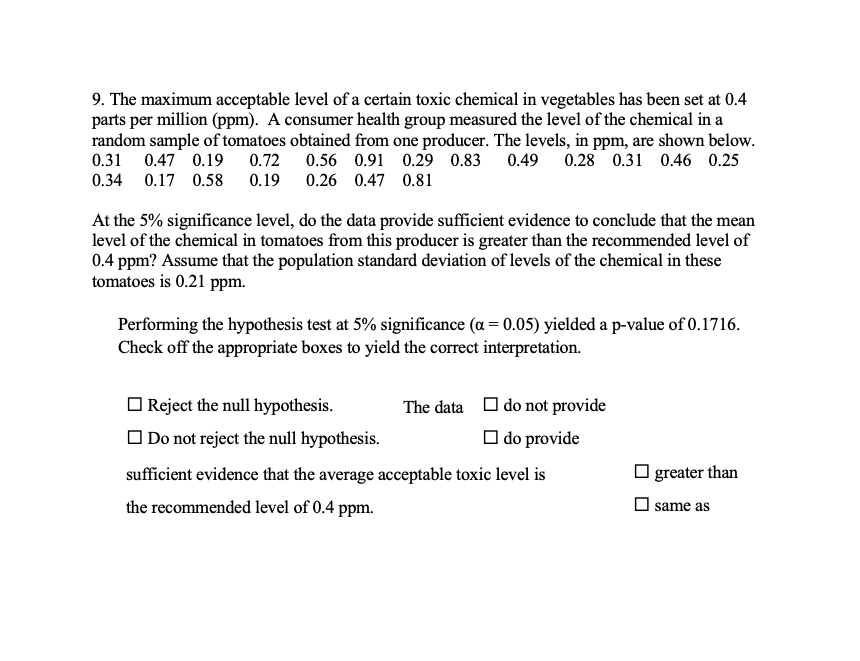9. The maximum acceptable level of a certain toxic chemical in vegetables has been set at 0.4 parts per million (ppm). A consumer health group measured the level of the chemical in a random sample of tomatoes obtained from one producer. The levels, in ppm, are shown below. 0.31 0.47 0.19 0.72 0.56 0.91 0.29 0.83 0.49 0.28 0.31 0.46 0.25 0.26 0.47 0.81 0.34 0.17 0.58 0.19 At the 5% significance level, do the data provide sufficient evidence to conclude that the mean level of the chemical in tomatoes from this producer is greater than the recommended level of 0.4 ppm? Assume that the population standard deviation of levels of the chemical in these tomatoes is 0.21 ppm. Performing the hypothesis test at 5% significance (a = 0.05) yielded a p-value of 0.1716.
9. The maximum acceptable level of a certain toxic chemical in vegetables has been set at 0.4 parts per million (ppm). A consumer health group measured the level of the chemical in a random sample of tomatoes obtained from one producer. The levels, in ppm, are shown below. 0.31 0.47 0.19 0.72 0.56 0.91 0.29 0.83 0.49 0.28 0.31 0.46 0.25 0.26 0.47 0.81 0.34 0.17 0.58 0.19 At the 5% significance level, do the data provide sufficient evidence to conclude that the mean level of the chemical in tomatoes from this producer is greater than the recommended level of 0.4 ppm? Assume that the population standard deviation of levels of the chemical in these tomatoes is 0.21 ppm. Performing the hypothesis test at 5% significance (a = 0.05) yielded a p-value of 0.1716.
Mathematics For Machine Technology
8th Edition
ISBN:9781337798310
Author:Peterson, John.
Publisher:Peterson, John.
Chapter29: Tolerance, Clearance, And Interference
Section: Chapter Questions
Problem 7A
Related questions
Question

Transcribed Image Text:9. The maximum acceptable level of a certain toxic chemical in vegetables has been set at 0.4
parts per million (ppm). A consumer health group measured the level of the chemical in a
random sample of tomatoes obtained from one producer. The levels, in ppm, are shown below.
0.31 0.47 0.19
0.72
0.56 0.91 0.29 0.83
0.49 0.28 0.31 0.46 0.25
0.34 0.17 0.58 0.19
0.26 0.47 0.81
At the 5% significance level, do the data provide sufficient evidence to conclude that the mean
level of the chemical in tomatoes from this producer is greater than the recommended level of
0.4 ppm? Assume that the population standard deviation of levels of the chemical in these
tomatoes is 0.21 ppm.
Performing the hypothesis test at 5% significance (a = 0.05) yielded a p-value of 0.1716.
Check off the appropriate boxes to yield the correct interpretation.
O Reject the null hypothesis.
The data
O do not provide
O Do not reject the null hypothesis.
O do provide
sufficient evidence that the average acceptable toxic level is
| greater than
the recommended level of 0.4 ppm.
same as
Expert Solution
This question has been solved!
Explore an expertly crafted, step-by-step solution for a thorough understanding of key concepts.
This is a popular solution!
Trending now
This is a popular solution!
Step by step
Solved in 2 steps with 2 images

Knowledge Booster
Learn more about
Need a deep-dive on the concept behind this application? Look no further. Learn more about this topic, statistics and related others by exploring similar questions and additional content below.Recommended textbooks for you

Mathematics For Machine Technology
Advanced Math
ISBN:
9781337798310
Author:
Peterson, John.
Publisher:
Cengage Learning,

Mathematics For Machine Technology
Advanced Math
ISBN:
9781337798310
Author:
Peterson, John.
Publisher:
Cengage Learning,